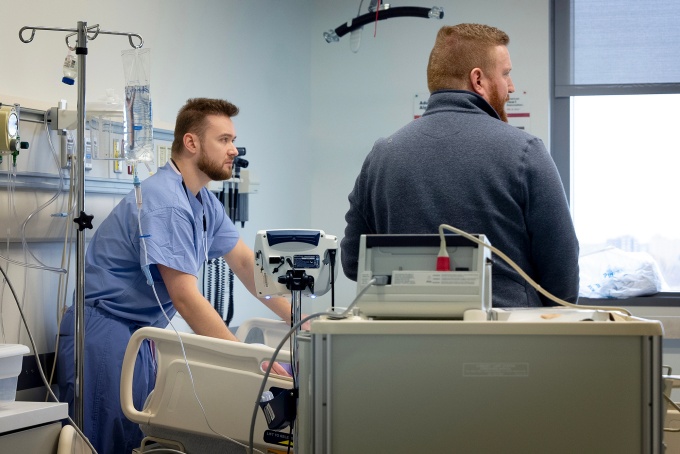Curriculum

From left, anesthesiology residents Boris Borovcanin, MD, and Logan Cooney, MD, train in the Behling Human Simulation Center lab.
Our curriculum stimulates and develops the intellectual and technical capabilities of every resident.
PGY-1
Your clinical base year includes Ward Medicine, Cardiology, MICU, Emergency Medicine, Pain Medicine and Anesthesiology (Pre-op/PACU).
In your first year of residency, there is predominantly a night float system during all obstetrics rotations. During the holiday season, we switch to a call system so residents can have time off. While doing special or outside rotations, a call system is also employed.
CA-1
Your CA-1 anesthesiology year is spent in a one-on-one tutorial relationship with a faculty member, learning the essentials of safe anesthesia. This tutorial training is complemented by an intensive didactic lecture series that covers the basics of anesthesia over a two-month curriculum.
For the balance of the first six months, you will progress through increasing levels of challenge in patient care, gaining expertise in the fundamentals of preoperative medical evaluation, intraoperative management and post-anesthetic care.
We use a call system that averages four overnight calls in a month. On average, most residents get two full weekends off a month.
CA-2 and CA-3
Over the next 24 months, your are exposed to more complex cases as well as specialty areas of anesthesiology.
During this period, you complete rotations outside of the operating room, providing an opportunity to function as a consultant for pain medicine, critical care and perioperative care.
We use a call system that averages four overnight calls in a month. On average, most residents get two full weekends off a month.
Simulation in Anesthesia
Our anesthesia simulator and mock OR has been designed to teach all levels of anesthesiology residents how to manage rare but critical events that transpire during the preoperative, perioperative and postoperative period.
Educational Stipend and Conferences
Residents in the University at Buffalo Anesthesiology Residency Program have access to the Resident and Fellow Educational and Professional Development Fund. This fund supports reimbursement for eligible educational and professional development expenses incurred during training. Eligible expenses include, but are not limited to:
- Travel and registration fees for conferences
- Textbooks and board preparation materials
- USMLE Step 3 and applicable board exam fees
- A one-time purchase of a computer or smartphone
Reimbursement is subject to an annual limit of $2,000 per resident and must comply with UB GME policies and procedures. All requests require prior approval from the residency program and the UB GME office.
For detailed information on eligible expenses and the reimbursement process, please refer to the:
Resident and Fellow Educational and Professional Development Fund Policy.
Memberships
We encourage you to become active members of the medical community in general and the anesthesia community specifically. The department pays your professional dues to the AMA and ASA as a demonstration of the importance of joining and participating early in issues that will affect one’s clinical practice.